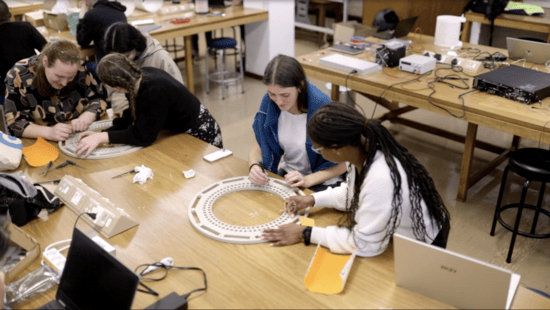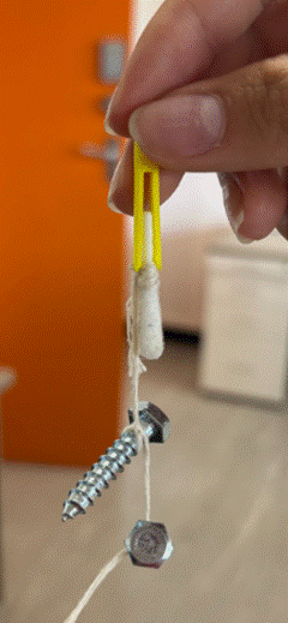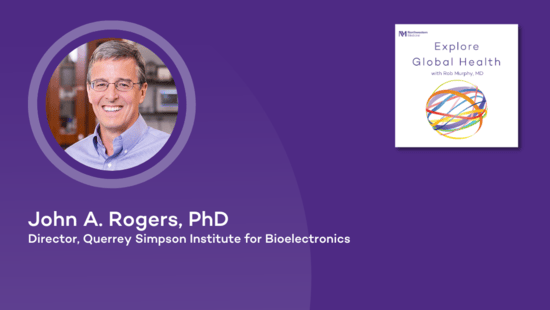Northwestern Scientists and Biomedical Engineering Students Contribute to Low-Field MRI System to Diagnose Tuberculosis Meningitis in Children

According to the World Health Organization (WHO), 10 million people become ill with tuberculosis (TB) every year. In South Africa and other countries with high burden of TB, a team from the Center for Innovation in Global Health Technologies (CIGHT) has supported the development of a new process to use tongue swabs for easier TB diagnosis. The team has collaborated on this process to lead it from early evaluations of the technology to consideration by the WHO.
Because TB is both preventable and curable, detection is key to high success rates. With the proper use of a simple tongue swab, the team hopes to save lives and prevent disease.
Working on the project are team members from the CIGHT, the Center for Innovation in Point-of-Care Technologies for HIV/AIDS and Emerging Infectious Diseases at Northwestern University (C-THAN), University of Washington, Stellenbosch University, University of Witwatersrand, Johannesburg (Wits University), University of Cape Town and Northwestern University students from the Department of Biomedical Engineering.
CIGHT team members include Matthew Glucksberg, PhD, and Sally McFall, PhD, co-directors, and Chad Achenbach, MD, MPH, associate director of the Robert J. Havey, MD Institute for Global Health and associate professor of Medicine in the Division of Infectious Diseases and Department of Preventive Medicine.



The swab capture device (pictured here) was developed by biomedical engineering students at Northwestern.
How it started
CIGHT, a center within the McCormick School of Engineering and the Feinberg School of Medicine's Robert J. Havey, MD Institute for Global Health, prioritizes the integration of complex healthcare solutions with patients and medical practitioners globally.
With that spirit in mind, CIGHT has been involved in TB diagnosis evaluation for years. The process began when C-THAN funded professors Jerry Cangelosi, PhD, from the University of Washington and Grant Theron, PhD, MSc, from Stellenbosch University started their project to improve the diagnostic yield of tongue swabs as TB specimens. Cangelosi then collaborated with McFall to develop a TB assay – a laboratory procedure to measure activity – for the DASH (Diagnostic Analyzer for Specific Hybridization) platform, currently being evaluated in Lesley Scott, BScHons, MSc, PhD's Wits Diagnostic Innovation Hub at Wits University.
The Wits team also collaborated with Sudesh Sivarasu, PhD, from the biomedical engineering department at the University of Cape Town. As the potential for the use of tongue swabs as specimens has been observed, the team explored using the swabs in highly automated systems, leading to an unforeseen challenge of how to remove the swab from the tube. To find a solution, Sivarasu and Glucksberg collaborated with the help of two Northwestern biomedical engineering students, Alyssa Eckels (Northwestern ’25) and Yanis Zaim (Northwestern ’26), to develop a prototype swab removal device.
Grant Theron, PhD, MSc, professor of Molecular Biology and Human Genetics at Stellenbosch University, presented "A Brief History of Tuberculosis and Recent Advances in Diagnosis" at the November 2024 IGH Seminar.
How the process works
At Wits University, an ultrahigh throughput platform was installed for SARS-CoV-2 testing from nasal swabs. As the need for this testing waned, team members proposed that the high throughput technology could be leveraged for TB testing from tongue swabs. The potential to reach more people with possible TB infection by using tongue swabs and an ultrahigh throughput solution could reduce ongoing, asymptomatic TB transmission.
The group ran into a problem when they discovered that the swabs used for tongue specimen collection were not compatible with the front-end automation of the high throughput platform. The specimens required manual processing, which was out of sync with the ultrahigh throughput nature of the platform, which aimed to process 5,000 specimens daily.
To resolve the issue, the team needed to develop a swab capture tool that could be scaled to remove swabs and return processing to high throughput. Eckels and Zaim designed a successful swab capture tool and presented the finished product to the Wits staff in March 2025.
What is the goal?
The goal of the project is to develop a new sample type for TB diagnosis. The standard of care is to test sputum for the bacteria that cause tuberculosis. However, many people – such as children and people living with HIV – have difficulty producing sputum, which leads to diagnosis obstacles while nearly everyone can provide a tongue swab specimen.
Tongue swab testing is a novel, non-invasive means to diagnose TB, and it will prove especially beneficial in community settings where most TB transmission occurs. The testing has the potential to simplify TB diagnosis, improve the care of many TB patients and enable active case-finding strategies that will reduce TB transmission. As a result, this idea could transform the global fight against TB.
"This project has high potential to many patients who are not able to produce sputum - the standard specimen - because tongue swabs can be collected from nearly every patient," McFall said.
The C-THAN network is helping to move this effort forward by developing novel point-of-care diagnostic platforms that capitalize on the simplicity of tongue swab samples and evaluating tongue swab methods in high-TB burden settings.
C-THAN is funded by the National Institute of Biomedical Imaging and Bioengineering (NIBIB) Point-of-Care Technologies Research Network (POCTRN), Fogarty International Center (FIC) and the National Institute of Health Office of AIDS Research.
This project has high potential to many patients who are not able to produce sputum (the standard specimen), and tongue swabs can be collected from nearly every patient.”
Chad Achenbach, MD, MPH, is a member of the Robert J. Havey, MD Institute for Global Health, Northwestern University Clinical and Translational Sciences Institute (NUCATS), Institute for Public Health and Medicine (IPHAM) and Robert H. Lurie Comprehensive Cancer Center.
To learn more about the Center for Innovation in Global Health Technologies, visit their website.
For details on events, news and funding opportunities, sign up for the Havey Institute for Global Health newsletter.

